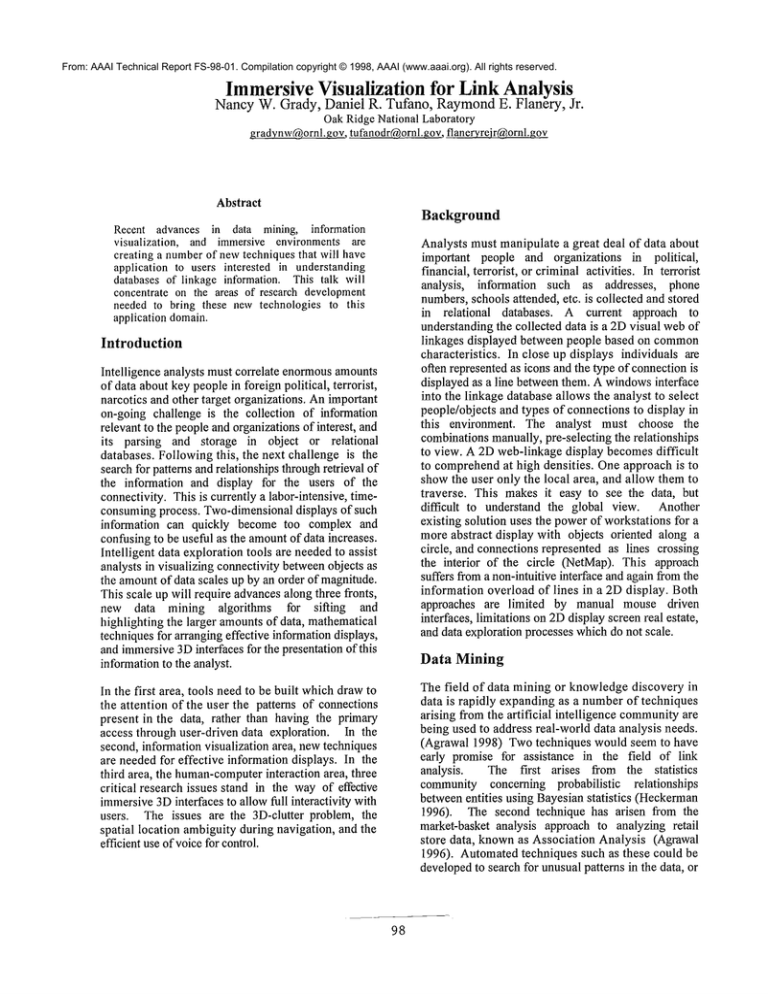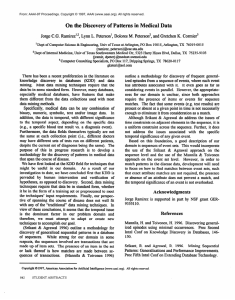
From: AAAI Technical Report FS-98-01. Compilation copyright © 1998, AAAI (www.aaai.org). All rights reserved.
ImmersiveVisualization for Link Analysis
Nancy W. Grady, Daniel R. Tufano, Raymond E. Flanery, Jr.
Oak Ridge National Laboratory
gradvnw(~,ornl.gov,tufanodr(~,ornl.gov, flaneryrejr@ornl.gov
Abstract
Background
Recent advances in data mining, information
visualization, and immersive environments are
creating a numberof newtechniques that will have
application to users interested in understanding
databases of linkage information. This talk will
concentrate on the areas of research development
needed to bring these new technologies to this
application domain.
Analysts must manipulate a great deal of data about
important people and organizations in political,
financial, terrorist, or criminal activities. In terrorist
analysis, information such as addresses, phone
numbers,schools attended, etc. is collected and stored
in relational
databases. A cmTent approach to
understanding the collected data is a 2D visual web of
linkages displayed between people based on common
characteristics. In close up displays individuals are
often represented as icons and the type of connectionis
displayed as a line between them. A windowsinterface
into the linkage database allows the analyst to select
people/objects and types of connections to display in
this environment. The analyst must choose the
combinationsmanually, pre-selecting the relationships
to view. A 2D web-linkage display becomesdifficult
to comprehendat high densities. One approach is to
show the user only the local area, and allow them to
traverse. This makes it easy to see the data, but
difficult to understand the global view. Another
existing solution uses the powerof workstations for a
more abstract display with objects oriented along a
circle, and connections represented as lines crossing
the interior of the circle (NetMap). This approach
suffers froma non-intuitive interface and again from the
information overload of lines in a 2D display. Both
approaches are limited by manual mouse driven
interfaces, limitations on 2Ddisplay screen real estate,
and data exploration processes whichdo not scale.
Introduction
Intelligence analysts must correlate enormousamounts
of data about key people in foreign political, terrorist,
narcotics and other target organizations. Animportant
on-going challenge is the collection of information
relevant to the people and organizations of interest, and
its parsing and storage in object or relational
databases. Following this, the next challenge is the
search for patterns and relationships throughretrieval of
the information and display for the users of the
connectivity. This is currently a labor-intensive, timeconsumingprocess. Two-dimensionaldisplays of such
information can quickly become too complex and
confusing to be useful as the amountof data increases.
Intelligent data exploration tools are needed to assist
analysts in visualizing connectivity betweenobjects as
the amountof data scales up by an order of magnitude.
This scale up will require advances along three fronts,
new data mining algorithms
for sifting
and
highlighting the larger amountsof data, mathematical
techniques for arranging effective informationdisplays,
and immersive3Dinterfaces for the presentation of this
informationto the analyst.
Data Mining
The field of data mining or knowledge discovery in
data is rapidly expanding as a numberof techniques
arising from the artificial Intelligence communityare
being used to address real-world data analysis needs.
(Agrawal 1998) Two techniques would seem to have
early promise for assistance in the field of link
analysis.
The first arises from the statistics
community concerning probabilistic
relationships
betweenentities using Bayesian statistics (Heckerman
1996). The second technique has arisen from the
market-basket analysis approach to analyzing retail
store data, knownas Association Analysis (Agrawal
1996). Automated techniques such as these could be
developedto search for unusual patterns in the data, or
In the first area, tools need to be built whichdrawto
the attention of the user the patterns of connections
present in the data, rather than having the primary
access through user-driven data exploration. In the
second, information visualization area, new techniques
are needed for effective information displays. In the
third area, the human-computer
interaction area, three
critical research issues stand in the way of effective
immersive3Dinterfaces to allow full interactivity with
users. The issues are the 3D-clutter problem, the
spatial location ambiguity during navigation, and the
efficient use of voice for control.
98
to allow the user to query using questions resembling
natural languageconstructions.
Information
synthetic environments productive for casual users.
Within any 3Ddisplay, the art is to provide a sense of
the overall distribution and spatial orientation, and to
allow specific features to be seen (Risch 1996).
second problem is the user’s comprehension of the
spatial location for a three dimensionalcursor (Kline
1996; Lampton1994). It is simple to present a 2D
location on a screen, but not whenthe third dimension
needs to be factored in. Visual cues must be used to
indicate location within the dataset (Drascic 1996).
Finally to eliminate an orientation shift, different input
modalities must be used to provide user input and
control. Lessons learned in the developmentofhehnetmounteddisplays for tactical aircraft have demonstrated
the value of voice control. The problems of clutter in
rendering and disorientation in display navigation and
interaction present a continuing critical need for
synthetic environments.
Visualization
An ongoing challenge in 3D rendering is the
placementof objects to indicate their relationship and
importance (Card 1998). While size, orientation and
color can indicate importance,the relationship itself is
best expressed in spatial terms. The difficult piece is
the translation of the attributes of abstract information
objects into their spatial placement on the screen.
There are two methods for determining the spatial
placement of "persons" in the visual environment,
deterministic and iterative.
In the first the
relationships must be calculated with an algorithm
which organizes and orients the data as a whole based
on the portions selected for viewing. Hierarchical data
has been displayed in 3D using most recently a
hyperbolic scheme (Munzner 1997). An interesting
2D display uses a sliding windowto view the local
display while maintaining
some view of the
surrounding data (Rao). The research need is
combine these two approaches to get a placement and
navigation system in 3D.
References
Agrawal, R.; Mannila, H.; Srikant, R.;Toivonen, H.;
and Verkamo, A. I. (1996). Fast discovery
Association Rules. In Fayyad, U. M.; PiatetskyShapiro, G.; Smyth, P.; and Uthurusamy, R., eds.,
Advances in Knowledge Discovery and Data Mining.
AAAI/MIT
Press. Chapter 12, 307-328.
The second possibility for object placement in 3D is
to makea first guess, and then use techniques common
in the physical sciences to adjust the placement.If the
relationship between two persons or objects is
expressed as a bond, the strength of that relationship
can be expressed mathematically as a force term to
determine the "distance" of the relationship.
Considering people or organizations to be analogous
to "molecules"in a liquid allows the use of traditional
iterative numerical methodsto find the 3D arrangement
according to the strength between them. This has a
further advantage of allowing a rapid update to see the
time evolution of the relationships,
or minor
adjustments. The initial placement could even come
from the results of data miningpattern recognition. A
newarea of investigation wouldbe this use of iterative
methods for information
placement
in 3D
environments, The advantage of this approach would
be the adaptation of a mature field of computational
research for data mining that wouldeasily handle new
and time evolving data.
Visual
Presentation
Agrawal, R.; and Stolorz, P. (1998). Proceedings of
the Fourth International Conference on Knowledge
Discovery and Data Mining. AAAIPress.
Card, S. K.; Mackinlay, J. D.; Shneiderman, B.
(1998). Readings In Information Visualization: Using
Vision to Think. Morgan-Kauffnann.
Drascic, D.; and Milgram,P. (1996). Perceptual Issues
in AugmentedReality. SPIE Volume 2653:
Steroscopic Displays and Virtual Reality Systems 111,
pp. 123-134.
Heckerman,D. (1996). Bayesian Networksfor
-KnowledgeDiscovery. In Fayyad, U. M.; Piatetskry
Shapiro, G.; Smyth, P.; and Uthurusamy,R.; eds.,
Advances in KnowledgeDiscovery and Data Mining.
AAAI/MITPress. Chapter 11,273-306.
Lampton, D. R.; Knerr, B. W.; Goldberg, S. L.;
Bliss, J. P.; Moshell, J. M.; and Blau, B. S. (1994).
The Virtual EnviommentPerformance Assessment
Battery (VEPAB):Developmentand Evaluation.
Presence, Vol. 3, No. 2, pp. 145-157.
and Interaction
Virtual Reality and immersive 3D-information
visualization are rapidly maturing fields. Once the
domainof the military, the emergenceof virtual reality
hardwareand so,rare at affordable prices is leading to
their use for many scientific
and commercial
applications. Whilethis technology offers the promise
of tremendouscapabilities, there are still a numberof
outstanding questions to be resolved to make 3D
Kline, P. B.; and Witmer, B. G. (1996). Distance
Perception in Virtual Environments:Effects of Field of
Viewand Surface Texture at Near Distances.
Proceedings of the HumanFactors and Ergonomics
Society 4dh Annual Meeting, pp. 1112-1116.
99
Munzner,T. (1997). H3: Laying out Large Directed
Graphsin 3DHyperbolic Space. In Dill, J.; Gershon,
N. eds.; IEEE Symposiumon Information
Visualization. IEEEComputerSociety Press. Pp. 210.
NetMap. http://www.ALTAanalytics.com/, or
http://www.netmap.com.au/.
Rao, R.; FromResearch to Real World, Inxight
Software. http://www.inxight.com/Content/91.pdf.
Risch, J.; May,R.; Thomas,J.; and Dowson,S.
(1996). Interactive InformationVisualization for
Exploratory Intelligence Data Analysis. Proceedings
of VRAIS’96, pp. 230-238.
i00





